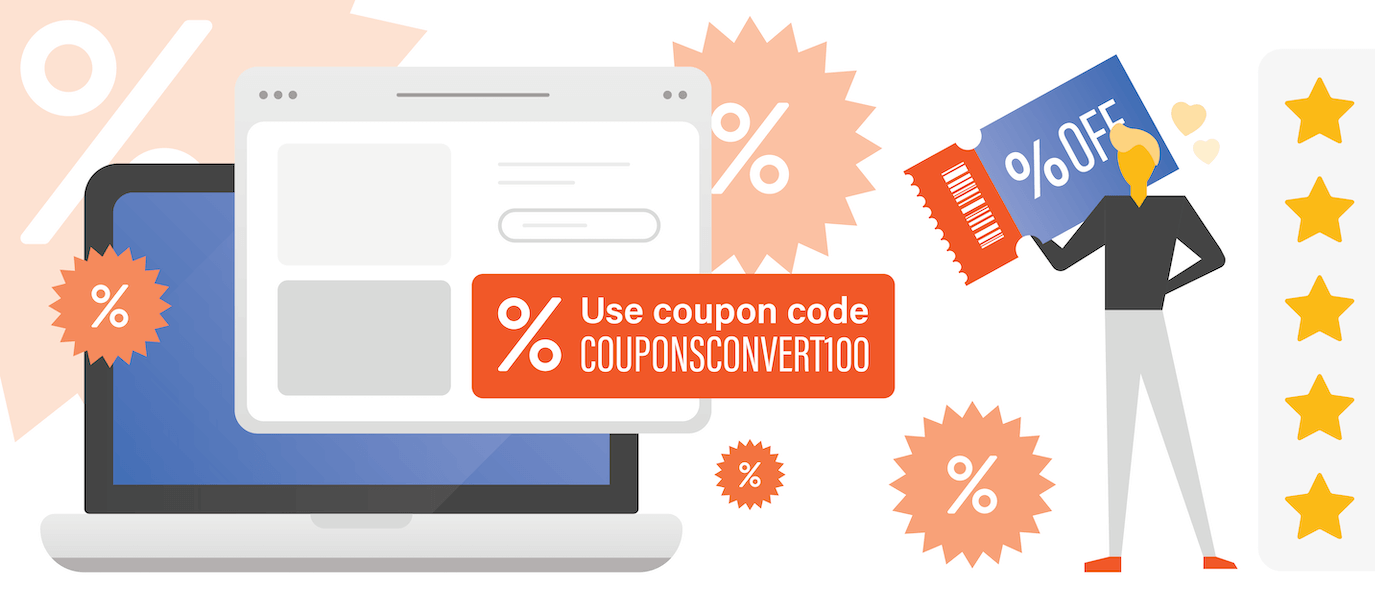
Unlocking Proven Strategies for Maximizing Your Coupon Impact and Converting Shoppers into Buyers
In the ever-evolving landscape of eCommerce, staying ahead of the competition often means harnessing the latest techniques to boost sales. One powerful tool at your disposal? The classic coupon. It might seem like a small piece of the puzzle, but when used correctly, coupons can turn hesitant browsers into enthusiastic buyers.
In this blog, we’ll explore the coupon’s profound impact on eCommerce sales. Whether you’re an established online retailer or just launching your digital storefront, understanding how to strategically use coupons can make all the difference in your bottom line. We’ll discuss proven tactics, share insights, and offer practical tips to help you use discount strategies to increase your sales conversion rates.
Why Entice Customers with Coupons?
The most widely known reason for distributing coupons is the positive response they always get from current and potential customers (no one dislikes spending less money!). Moreover, coupons can also result in the following:
1. Enhance CLV & Encourage Repeat Purchases:
When customers are offered coupons, they’re often enticed to return to your business again. This potentially increases their loyalty and their overall lifetime value.
2. Gather Customer Data & Generate High-Quality Leads:
When customers sign up to receive coupons, you gain access to their contact information, allowing you to build a database of potential customers for future marketing efforts.
3.Decrease Abandoned Cart Rate
Offering a coupon during the checkout process can motivate hesitant customers to complete their purchases, ultimately leading to less likelihood of abandoned shopping carts.
These combined benefits make coupons a vital tool in your eCommerce sales conversion strategy, as they not only drive immediate sales but also foster long-term customer relationships and data-driven marketing opportunities.
Discounts vs. Coupons
Distinguishing between coupons and discounts is crucial in understanding their distinct roles in your eCommerce strategy. While these terms are often used interchangeably, they represent separate concepts. Both coupons and discounts allow customers to acquire products or services at a reduced cost, but it’s essential to approach them differently to avoid any confusion.
Coupons are tailored for individual buyers and typically involve shareable codes. They are a targeted marketing tool, frequently used by businesses to reach specific audiences. When a potential customer comes across a coupon code, they can apply it during the checkout process to receive a designated discount. This approach provides businesses with valuable insights into their customer’s journey, helping them identify where the particular customer discovered the discount.
On the other hand, discounts, while potentially also directed at specific audience segments, are generally accessible to all customers making a purchase. These eCommerce promotions typically involve certain products offered at a reduced price. For example, a company might provide a 10% discount on a particular product for a specified day.
Again, understanding the disparity between coupons and discounts is crucial, as it allows you to leverage them effectively in your eCommerce endeavors. Now that we’ve clarified their differences, we’ll discuss why you should incorporate them into your strategy and how to use them optimally.
The Best Ways to Implement Coupons
When it comes to implementing coupons effectively, there are several key strategies to consider. First, personalized offers for specific customer segments prove highly effective. Tailoring your coupon offers to match the preferences and purchase history of individual customer segments can significantly boost their impact. By creating coupons that resonate with each segment, you can expect higher redemption rates and increased customer satisfaction, ultimately driving eCommerce sales.
Another powerful strategy is to create a sense of urgency and FOMO (Fear of Missing Out) through the use of flash sales with limited-time coupons. Offering time-limited discounts prompts quick decision-making among your customers. To maximize the impact of these flash sales promote them across various marketing channels.
Coupons can also be strategically used to promote non-selling or slow-moving inventory. Offering discounts on these item can help you clear out excess stock while increasing visibility of lesser-known products or items that draw less interest and attention. This facilitates inventory management and introduces customers to items they may not have considered otherwise.
Exchange Of Value
The exchange of value is a fundamental aspect of an effective coupon strategy, where customers receive tangible benefits in return for their engagement and loyalty. Here are four key methods for directly exchanging customer value for coupons:
1. Referral Programs:
Referral programs offer customers the chance to earn coupons or discounts by referring new customers to their business. This exchange of value benefits both existing and new customers. For instance, a customer can refer a friend to your eCommerce store, and upon their friend’s first purchase, both the referrer and the referee receive a coupon code for a discount on their next order. This not only drives new customer acquisition but also rewards and retains existing customers.
2. Newsletter/Landing Page Sign-ups:
Encouraging customers to sign up for newsletters or engage with your landing pages in exchange for exclusive coupons is a valuable tactic. For instance, a customer visiting your landing page might be prompted to enter their email address in exchange for a 10% discount on their first purchase. This not only builds your email subscriber list but also provides customers with an immediate incentive to make a purchase.
3. Loyalty Programs:
Loyalty programs are an effective means of exchanging value with customers over the long term. As customers make repeat purchases, they accumulate points or rewards that can be converted into coupons or discounts. For example, a coffee shop could have a loyalty program where every 10th coffee is free, providing a tangible value exchange that incentivizes repeat business and customer loyalty.
4. Feedback Rewards:
Encouraging customers to provide feedback on their experiences, whether through reviews, surveys, or product ratings, can be rewarded with coupons or discounts. For example, a clothing retailer may offer a 15% off coupon in exchange for a customer leaving a product review on their website. This not only collects valuable feedback but also drives engagement and future purchases.
These methods of direct value exchange create a win-win situation, where customers receive immediate benefits while businesses gain valuable customer data, referrals, engagement, and loyalty.
Promote Your Coupons
Effectively promoting your coupons is key to maximizing their impact. Several strategies can help you get the word out and engage customers:
1. Pop-Ups:
Employ pop-up windows on your website to instantly capture visitors’ attention and entice them to take advantage of your coupons. Ensure that these pop-ups showcase compelling offers in a visually appealing and user-friendly manner, prompting immediate action.
2. Make Your Offers Apparent:
Make sure your coupons are highly visible on your website. Place them in prominent locations, including your homepage, product pages, and cart checkout to ensure that customers easily spot these potential savings. It’s also important to pay attention to the visual appeal of your coupons to ensure they stand out on your website. Utilize eye-catching design elements, vibrant colors, and clear, concise copy to make them visually attractive and easily noticeable.
3. Email:
Utilize targeted email campaigns to reach your subscribers, emphasizing the availability of your coupons. Customize these emails to cater to different customer segments, clearly conveying the value of the coupon and creating a sense of exclusivity.
4. SMS:
Harness SMS marketing to reach customers directly on their mobile devices. Craft concise, engaging messages that include coupon codes and a compelling call to action, simplifying the redemption process for recipients.
5. Social Media:
Leverage your social media platforms to promote your coupons effectively. Create attention-grabbing posts and stories that highlight the benefits of using the coupon. Encourage sharing to expand the reach of your promotions and consider using paid advertising to target specific demographics.
By implementing these diverse promotional methods, you can ensure that your coupons are widely seen (and hopefully, widely used).
Monitor Success
To ensure the success of your coupon strategy, monitoring and analyzing is crucial. The promotional code serves as an effective tool to track and measure marketing efforts. One way to optimize coupons is through A/B testing, where you can compare the performance of different coupon offers, delivery methods, or presentation. By employing various coupon codes through A/B testing, you can measure the effectiveness of each coupon variation, gaining valuable insights into what resonates with your audience.
Also, utilizing the coupon conversion formula, calculated as…
Coupon Conversion = (Coupon Used / Coupons Given) x 100
…allows you to assess the impact of your coupons accurately. This formula provides a clear picture of how many coupons are redeemed relative to the number distributed, helping you fine-tune your coupon strategy.
Optimize Coupon UX
Lastly, optimizing the coupon user experience (UX) is essential to enhance customer satisfaction and maximize coupon usage. To achieve this, consider the following strategies:
1. Visible and Well-Designed Coupon Field:
Ensure that the coupon field is prominently displayed and visually appealing. A well-designed coupon entry field not only enhances the UX but also makes it easy for customers to apply discounts. Additionally, you may want to consider hiding the coupon code field if your website typically doesn’t offer coupon codes. This prevents unnecessary confusion and frustration for customers who might search for codes that aren’t applicable.
2. Pre-Discounted Links:
Rather than relying solely on coupon codes, offer pre-discounted links or URLs that automatically apply the discount when users click on them. This streamlined approach simplifies the process for customers and eliminates the need for them to manually enter coupon codes, creating a smoother shopping experience.
3. Effective Language Use:
Ensure that your coupon-related messaging is both clear and compelling. Use persuasive language to convey the value of the coupon and the benefits it offers to customers. Highlight any unique selling points and emphasize limited-time offers to entice customers to take full advantage of the discount.
Looking to achieve higher conversions? Strata’s custom marketing services are designed to drive results, increase engagement, and boost your ROI. Let’s work together to increase your eCommerce conversions. Contact us today.
Back to Blog


